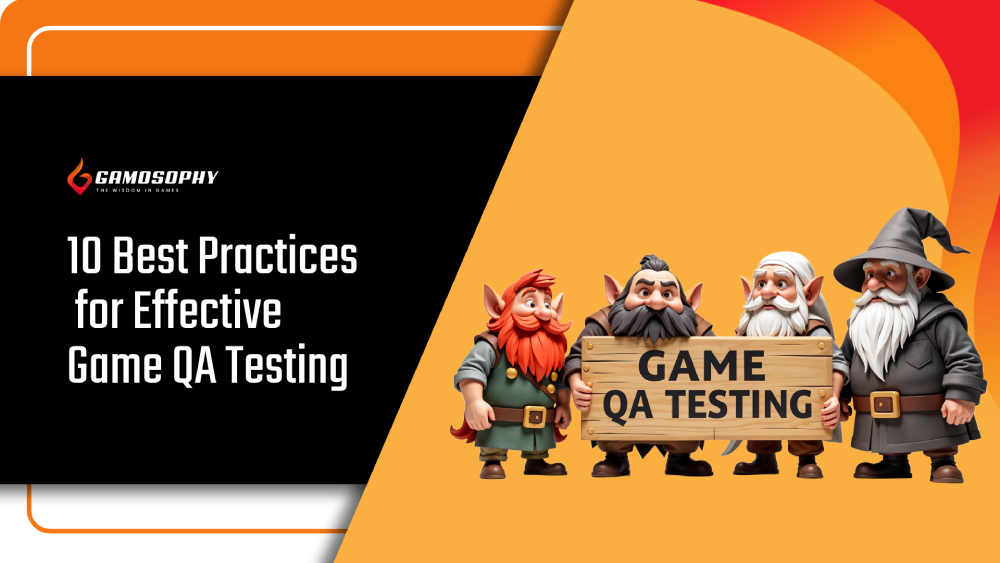In the fast-evolving world of video game development, game QA testing has become a critical pillar that determines whether your game will launch successfully or suffer from poor ratings and user churn. A single bug or compatibility issue can derail months of development by causing app store rejections, refund requests, and social media backlash.
The importance of a well-planned QA process cannot be overstated. Fixing a bug in production can cost up to five times more than identifying it during the development phase. That’s why studios today are shifting left — integrating QA early and strategically throughout the game development lifecycle.
In this post, we’ll walk you through 10 game QA testing best practices that every studio — from indie devs to AAA giants — should implement to ensure a smooth, high-quality release.
Start QA Early in Development
- Unit testing for game logic and mechanics
- Prototyping validation (e.g., core gameplay mechanics working as intended)
- Static code analysis tools for early bug detection
Create a Detailed Test Plan and Test Cases
- Alpha Testing: Feature completion, smoke testing, unit testing
- Beta Testing: Broader scenario and stress testing, localization
- Release Candidate Testing: Compliance, regression, final bug triage
Use tools like JIRA, TestRail, or Zephyr to manage:
- Test case libraries categorized by gameplay area or feature
- Bug lifecycle tracking with reproducible steps
- Progress reporting and test coverage metrics
Balance Manual and Automated Testing
Both manual and automated testing have their roles in a well-rounded QA strategy. The key is knowing when and how to use each.
Automated Testing
- Repetitive tasks like running through level sequences
- Smoke tests that validate core functionality
- Performance profiling under varied loads
- Verifying UI element consistency, screen transitions
Appium, Selenium, TestComplete, Unity Test Runner
Manual Testing
- Exploratory testing (unstructured gameplay)
- UI/UX feedback and fun-factor validation
- Testing edge cases or physics anomalies
- Verifying game feel, tone, difficulty balancing
💡 Best practice: Combine both testing types. Use automation to scale, and manual QA for qualitative feedback and polish.
Test on Real Devices & Multiple Platforms
Emulators can help during early testing, but relying solely on them is risky. Real-world issues often surface only on actual devices.
- Mobile QA: Test across devices (Android fragmentation, iOS versions)
- PC Games: Test on varied hardware (GPUs, RAM, CPUs, OS versions)
- Console Games: Ensure compliance with Sony/MS TRC (Technical Requirements Checklist)
This practice addresses compatibility testing challenges and helps avoid post-launch issues like crashes or control mapping failures.
Include Localization and Cultural Testing
A global player base means your game must pass both linguistic and cultural QA.
- Ensure UI accommodates translated text length
- Use native speakers for tone accuracy
- Test right-to-left (RTL) language rendering
- Check region-appropriate references and content
Example: A gesture, phrase, or symbol harmless in the West might offend users in the MENA region. Cultural QA helps avoid costly retractions or rating issues.
Performance and Load Testing
Nobody wants their server to crash on launch day.
QA teams must stress test the game by simulating:
- Thousands of concurrent users (especially for online or MMO titles)
- Extended play sessions (memory leaks, overheating)
- Variable network conditions (packet loss, latency spikes)
- LoadRunner or Apache JMeter for network load simulation
- Unity Profiler / Unreal Insights for FPS/memory monitoring
- Automated bots to simulate gameplay behavior for long durations
This ensures your game remains stable under real-world conditions.
Regression Testing after Fixes
- Maintain a regression test suite
- Automate high-priority regression scenarios using CI/CD
- Run nightly builds with automated tests
- Manually validate high-risk areas after major changes
Engage in Beta Testing & Player Feedback
Engaging your players during closed or open beta is a game-changer.
Why it’s essential:
- Real-world feedback on difficulty, pacing, bugs
- Identifies blind spots missed by internal QA
- Helps validate performance on diverse hardware
- Use platforms like Steam Playtest, Discord servers, or TestFlight
- Unity Profiler / Unreal Insights for FPS/memory monitoring
- Automated bots to simulate gameplay behavior for long durations
This ensures your game remains stable under real-world conditions.
Document and Prioritize Bugs Effectively
Use a bug triage format like:
- Severity
- S1
- S2
- S3
- S4
- Description
- Game crash, progress blocker
- Major issue, but workaround possible
- Minor visual/UI bug
- Cosmetic or polish-level issue
- Add steps to reproduce
- Include screenshots or video
- Clearly assign to related feature/component
- Track fix verification cycles
Perform a Final Pre-Launch QA Checklist
Your pre-launch QA checklist should include:
- ✅ All S1 and S2 bugs resolved
- ✅ Final platform compliance (App Store, TRC, PEGI/ESRB)
- ✅ Last smoke test run on every supported platform
- ✅ Localization double-check in all markets
- ✅ Confirm build numbers and version control tagging
Stay tuned for our detailed Pre-launch Game Testing Checklist — coming soon!
Conclusion
By following these 10 game QA testing best practices, studios can drastically reduce post-launch surprises, negative reviews, and player churn. Quality assurance isn’t just about finding bugs — it’s about delivering an unforgettable and stable gaming experience.
🧠 Fun Fact: According to PCMag, bugs and crashes were the #1 reason for app store rejections.
Are you confident your current QA strategy covers all these bases? If not, our team at Gamosophy can help. Explore our game testing services or contact us for a free QA consultation today.
FAQs
Q2: How much QA is enough for an indie game?
While budget is limited, even indie games should prioritize testing core gameplay, device compatibility, and crash-free operation. Leveraging beta testers can help extend QA coverage.




